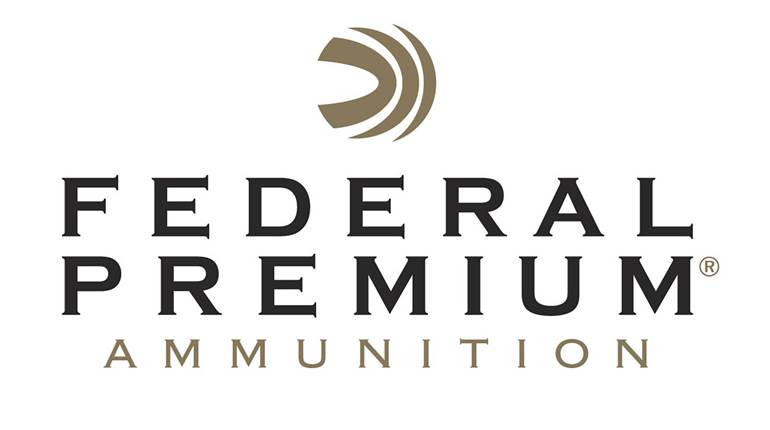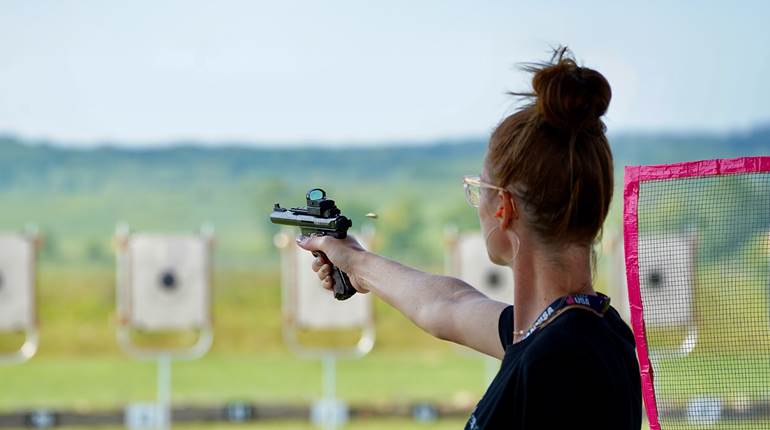
Compared to other categories, technical advancement within the realm of muzzleloading is fairly modest, and when something noteworthy comes along, it is bound to create controversy within this small but ardent shooting sport. Critics will invariably pronounce anything too new or too different, “not a muzzleloader.”
In the case of the bold new Traditions NitroFire/Federal FireStick joint venture, there’s a semantic justification, at least, because the NitroFire rifle is designed with an open breech. That opening, sans breechplug, allows for insertion of the FireStick, a pre-charged, sealed capsule resembling a shotshell and containing Hodgdon’s Triple Eight blackpowder substitute. The bullet, however, true to age-old practice, is loaded from the front with a ramrod.
Oddly enough, that’s the same argument traditionalists raised when Tony Knight ushered in “modern muzzleloading” with his MK-85 rifle 36 years ago. We heard as much from one former American Hunter muzzleloader correspondent who, despite surging interest in Tony’s inline design, refused to write about the guns because they didn’t conform to his notion of what “blackpowder shooting is all about.”
Certainly everyone is entitled to their own opinions, but at the risk of missing the boat. Unlike our writer, a keen student of firearm history, a new breed was swiftly emerging, hunters whose desire for more time afield via special blackpowder seasons for deer, elk and other game involved little or no interest in reliving history. They just wanted reliable hunting rifles. What we learned then is that free-market demand shapes technical development—including what constitutes a muzzleloader in the 21st century.

A Hybrid Loader
The NitroFire rifle design springs from Traditions’ highly regarded Pursuit series. Imported from Spain, it is from the hinged/break-open, manual-hammer-cocking school that has dominated contemporary muzzleloading for two decades because there are fewer parts to clean or malfunction and because breech access, for priming and cleaning, is a snap. The Traditions’ hinge release is a handy button at the front of the trigger guard, its large size and location providing leverage to ease the opening of the action.
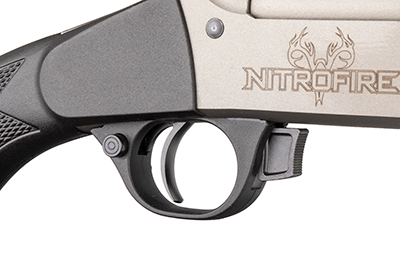
The NitroFire offers twin safeties, consisting of a cross-block trigger safety and an internal hammer-block safety, plus the proprietary Elite XT Trigger system, which incorporates a rebounding hammer and a captive half-cock that allows the action to be opened with the cross-bolt safety still engaged. Made in .50-cal. only, it comes with a 26", 1:28"-twist, chrome-moly steel barrel that’s tapered and fluted for weight savings. An aluminum, T-handle ramrod is part of the package. All in, the rifle tips the scales at a trim 6 lbs., 9 ozs. With the lines of a modern hunting rifle, the NitroFire’s two-piece stock is offered in several camouflage treatments, as well as in basic black, all of which are complemented by a durable Cerakote Gray metal finish. Kit models with a factory-installed 3-9X 40 mm Traditions scope are also offered. For more NitroFire details and observations, see the hunting sidebar below.
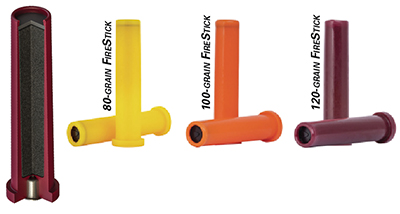
Propellant
Like shotshells, FireSticks are color-coded for instant recognition. Initial offerings, loaded exclusively with Hodgdon’s Triple Eight propellant and sold with 15 shots per package, were 100-grain orange and 120-grain maroon versions, and added recently was an 80-grain load in yellow. According to Federal, the molded hulls—2.89" long by 0.59" in diameter—were carefully designed to not fit or be fired in existing centerfire guns. They slip easily, but with a snug fit, into the NitroFire’s open breech. FireSticks bear their own headstamp and come with a modified roll crimp that secures a black plastic overwad. A pocket for 209 primers is molded into the base. Interestingly, there’s no flashhole, and apparently none is needed. As such, it’s a sealed container that is all but impervious to moisture.
In this system, the front-loaded bullet does not actually seat firmly on the powder charge. The NitroFire bore features a small annular shelf on which the bullet’s base (sabot) seats, a stop that uniformly positions the bullet shot after shot. The FireStick’s crimp seats on the opposite side of the ring, preventing actual contact. Though that slight gap contravenes traditional loading technique, Federal product developers assured us it was for good reason:

“Extensive testing was done on compressed loads versus slightly loose powder, and no difference was seen in the consistency of the ballistic response with this propellant. This lack of compression is by design, to balance manufacturability with reliability. Loose powder has a tendency to settle over time, which is why the black (end) disk is not sitting directly on the propellant. If it were, the disk would settle with the propellant over time (in transit, handling, etc.) and create an air gap between the crimp and disk, impacting the ability to seal out moisture. Instead, the disk sits on an internal shelf within the FireStick hull, which captures it securely between that and the crimp. This always ensures a tight seal. The flexibility to slightly vary the propellant charge gives us the ability to compensate if there is ever variation from one lot of propellant to the next.” Here’s what American Rifleman Managing Editor Christopher Olsen and I found during the course of testing the hybrid system on the range and on a deer hunt.
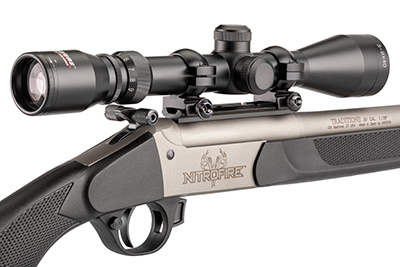
Safety & Performance
Hunters will immediately note the safety advantage of the FireStick/NitroFire pairing. The propellant can be instantly and securely loaded—without tools, in the dark, in rain and wind, up in a treestand—and just as neatly unloaded without firing a bore-clearing shot and free from the effort, waste and mess of dumping one’s load in the woods or where you parked. You can now quit driving back to camp or home with powder and ball confined in the bore of the rifle behind your seat. While doing so is legal so long as the primer or cap is absent, and while that practice has not resulted in a spate of unintended discharges, many of us still find it cringeworthy. What’s more, the system eliminates accidental double-charges, and, if the user is ever in doubt, a visual check of the bore is simple.
Federal emphasizes the precision built into the FireSticks. Loaded in the same plant on the same machinery as the company’s vaunted cartridge ammunition, the inherent charge-volume consistency is an accuracy-control factor. We checked the contents of five each of the 100- and 120-grain charges and found that the company’s mass-production powder-charging operation can put some of us handloaders to shame. The extreme spread of the 100-grain charges was a paltry 0.05 of a grain and for the 120s, it was 0.1 of a grain. Indeed, a few errant particles may have been the only bar to perfection. When actually weighed on a scale, a sampling of 100-grain FireSticks averaged 59.9 grains of Triple Eight, while the 120-grain charges averaged 70.8 grains. Please note that disparities between volume and actual weight are common for substitute powders because the volume standard is based on original blackpowder.
Volumetric inspection proved to be tricky, since Triple Eight is formulated in granules that look like mini soda straws and which don’t compress as neatly as “flake” powders. The charges settle, though not evenly. But all that’s moot, since FireSticks spare users the chore of measuring or weighing their charges. We haven’t seen burning-rate data on the “soda-straw” propellants (the popular Blackhorn 209 is similar), but we know they produce higher velocities per volume than other loose-powder substitutes, and pelletized powders are even less efficient.
Chronograph testing proved the point, and muzzle velocities were even faster than we anticipated. Pushing Traditions’ 250-grain Smackdown Carnivore Ridgeback, a tipped projectile in a ridged sabot, the system averaged 2,013 f.p.s. with 100-grain FireSticks, and 2,230 f.p.s. with the 120-grain loadings. By comparison, pelletized 100-grain charges behind similar bullets typically generate 1,600 to 1,700 f.p.s., and a ballistics table at traditions.com shows the Carnivore 250 hitting 2,120 f.p.s. with 120 grains of Blackhorn 209. The result of the faster FireStick/Triple Eight loads is increased energy and flatter trajectory, though the latter is limited somewhat by the bullet’s relatively low ballistic coefficient.
In addition to testing the 270-grain Federal Trophy Copper with the 120-grain FireStick, we also tested Traditions’ 250-grain Smackdown Carnivore and PowerBelt’s 245-grain Copper Aerotip with the 100-grain FireStick charge. The accuracy results for each are tabulated nearby. Across the board, velocity data remained consistent, with relatively low standard deviation between shots. The sampled loads provided practical accuracy out of the NitroFire sufficient for big-game hunting, even at distance.
To test efficacy at distance with the Traditions Smackdown Carnivore and sabot, backed by a 120-grain FireStick charge and Federal Premium primers, we fired two five-shot groups on target. The first group, at the target’s top, was placed on target at a distance of 100 yards. We then moved the same target to the 200-yard mark for another string of fire. Five shots printed on the target roughly 8.5" below the 100-yard point of impact, proving the gun’s effective point-blank range. It is important to note that one extreme flier was captured at 200 yards and discounted from the measured group due to shooter error. Interestingly, we cross referenced the sampled ballistic data with Hornady’s free online ballistic calculator and found that the provided digital results were within a tenth of an inch of our real-world sampling.
Cleaning
The makers’ claims for easy cleanup proved spot-on during our range sessions. After firing 10-shot strings, we found just five pre-soaked patches were needed to remove all signs of powder fouling. That’s as good as it gets. Though the patches did show lingering signs of what we think is plastic fouling, that is common wherever sabots are in use.
Rather surprising to us, the breech area wasn’t as heavily coated with gunk as is typically seen in breechplug rifles. We’re unsure if that’s solely because Triple Eight burns so cleanly, or if reduced back-pressure somehow contributes, perhaps allowing a different dispersal pattern. One thing is certain—NitroFire owners shouldn’t get bogged down on maintenance. Even so, it’s a chore that can’t be ignored, because, while improved, Triple Eight is still a blackpowder substitute and still corrosive. Be advised, Federal says FireStick cleanup requires solvent and that water-based swabbing won’t cut it.
Legal Status
Because of its breechloading aspect, BATFE classified the NitroFire as a modern firearm. As such, purchasers must go through FFL dealers and submit a Form 4473 for the FBI background check. Subsequent changes in ownership and other transfers are regulated the same as with other modern guns. However, like blackpowder and other substitutes, Triple Eight is classified as an explosive, not as ammunition. As such, and unlike loaded modern cartridges, it cannot be transported aboard commercial airliners.
According to Traditions, as of this writing, 18 states have approved the FireStick/NitroFire system for use in dedicated muzzleloader seasons, and another 18 states have indicated it is under consideration. We’re reminded that, early-on, then-new inline muzzleloaders were similarly slow-walked through state approval processes. Tony Knight traveled extensively, lobbying legislators and wildlife managers, and while it took years, nearly all states with special seasons eventually permitted inlines in some fashion. We expect the FireStick/NitroFire admittance to muzzleloader seasons will spread but will also take time.
The legal status will certainly have an effect on how well the FireStick system catches on. But the shooting public’s interest in the FireStick, along with the chance other gunmakers will adopt it, will likewise influence the regulatory folks. Given its inherent safety and convenience, we think serious pushes will come in several states. Hunters in states where it is eligible for special seasons are already expressing great interest. And beyond that, it’s a great way to teach beginners not just about muzzleloading but about gun safety and how guns work.
 NitroFire On The Hunt
NitroFire On The Hunt
As an avid bowhunter, I look forward to trading out the archery tackle each year in favor of blackpowder, lead bullets and muzzleloading rifles. These guns afford the primitive-oriented hunter extended range and lethality to ethically harvest game at distances beyond the capability of a bow. In addition, specialized hunting seasons for guns that load through the muzzle give the outdoorsman an extra weekend or two a year to hunt, and I love more time in the field.
For evaluation, Traditions sent a NitroFire kit gun with an included 3-9X 40 mm riflescope and, after a quick boresighting, it took just a few shots to get the NitroFire dialed in. Prior to an Oklahoma whitetail hunt during the state’s dedicated Primitive Arms season, I tested the system, finding it to be accurate both on the range and in the field. While the optic included with the NitroFire was fine, I’m certain that premium glass with increased magnification would improve results considerably.
 Late October is a special time of the year to hunt whitetails—antler bucks have left summertime bachelor groups, and spring-born fawns and does alike begin to seek out highly palatable, high-protein food to fill their stomachs for the winter. Antlered males begin to move more frequently, often abandoning their defensive instincts in favor of a chance to breed. For these reasons, muzzleloader season can provide some of the best hunting to be had all year.
Late October is a special time of the year to hunt whitetails—antler bucks have left summertime bachelor groups, and spring-born fawns and does alike begin to seek out highly palatable, high-protein food to fill their stomachs for the winter. Antlered males begin to move more frequently, often abandoning their defensive instincts in favor of a chance to breed. For these reasons, muzzleloader season can provide some of the best hunting to be had all year.
I was greeted by an unprecedented storm once I arrived in Oklahoma City. Mind you, this is an area that typically doesn’t receive much ice and snow accumulation like the northern parts of the country. Having hunted in snow and ice much of my life, I knew this meant that upset deer would traverse the newly frozen environment within 24 hours in search of buried food and much-needed warmth. The forecast after the storm also didn’t look too promising—80 degree days capped with clear, full-moon nights. So I knew that I needed to put in as many hours in the field as possible while the wintry blanket remained.
First and foremost, before heading to the blind after traveling halfway across the country, it was imperative to confirm that the scope’s zero had not shifted. This did not take long to do, but it was where I experienced a hiccup with the system. The FireStick hull is sealed and opens from the front once ignited, leaving a plastic circular ring that was later found stuck to my breech brush. This explained to me why the action suddenly became stiff to close. I first thought it was a fluke, but then encountered it with several more FireStick hulls during testing.
The next morning, I found that a light mist throughout the night had frozen onto every exterior surface. My stomach fluttered with excitement for what was about to unfold. With the NitroFire slung snug on my shoulder, my favorite Alpz backpack filled with a morning’s worth of rations and supplies and binos strapped to my chest, I headed for the blind. As was expected, the blind was completely encrusted with a thick layer of dense ice.
By the time I settled inside the plastic shanty, my hands were soaked and halfway numb. Cold and wet hands are not conducive to loading most muzzleloaders, but I found that this was not the case with the NitroFire. A 250-grain Carnivore slipped down the bore with minimal effort. I then pointed the barrel out of the blind’s flip-up front window to ready my position for the morning’s hunt. This is the moment the distraction began.
 Does filtered from the draw to my right down toward the game feeder that was placed in front of me. I spotted more movement and found that a small buck had just made his way to the feeder. Then a shot-worthy buck appeared. From across the field of interspersed sage brush, I could see his dark, wet antlers attempting to stab the sky above him. He presented a rigid posture and seemed to be staggering toward me, but I knew that his focus was actually on the immature buck.
Does filtered from the draw to my right down toward the game feeder that was placed in front of me. I spotted more movement and found that a small buck had just made his way to the feeder. Then a shot-worthy buck appeared. From across the field of interspersed sage brush, I could see his dark, wet antlers attempting to stab the sky above him. He presented a rigid posture and seemed to be staggering toward me, but I knew that his focus was actually on the immature buck.
The closer he stamped, the bigger he appeared. His character was dominant and his antlers were interesting—with two abnormal tines jutting outward off of each G2 tine—he was a double-kicker buck, with dark antlers highlighted by ivory-like tips. I got the shakes, and it was only after pulling the trigger that I realized that I had forgotten to charge the NitroFire.
I fumbled through my pocket and withdrew a primed FireStick. I was certain that the buck would bolt when I unhinged the action, inserted the charge and closed the action, but he was too distracted by the other deer to notice me. He was quartered toward me at roughly a 45-degree angle as I took aim and fell over shortly after I fired. I quickly prepared a second shot but didn’t need it. The 250-grain tipped bullet had proven effective, and just like that, I had a beautiful Oklahoma specimen to write home about.
The simplicity of the system helped me when I was in a pinch; had I forgotten to add powder to a conventional inline before bullet seating, a call to the lodge for tools would have been needed, and I’ve never carried a bullet puller in the field while hunting either. But thanks to the NitroFire/FireStick combination, I didn’t lose the buck.
—Christopher Olsen, Managing Editor
If you are new to muzzleloading, or interested in learning more, your NRA can help. Go to nrainstructors.org for more.












